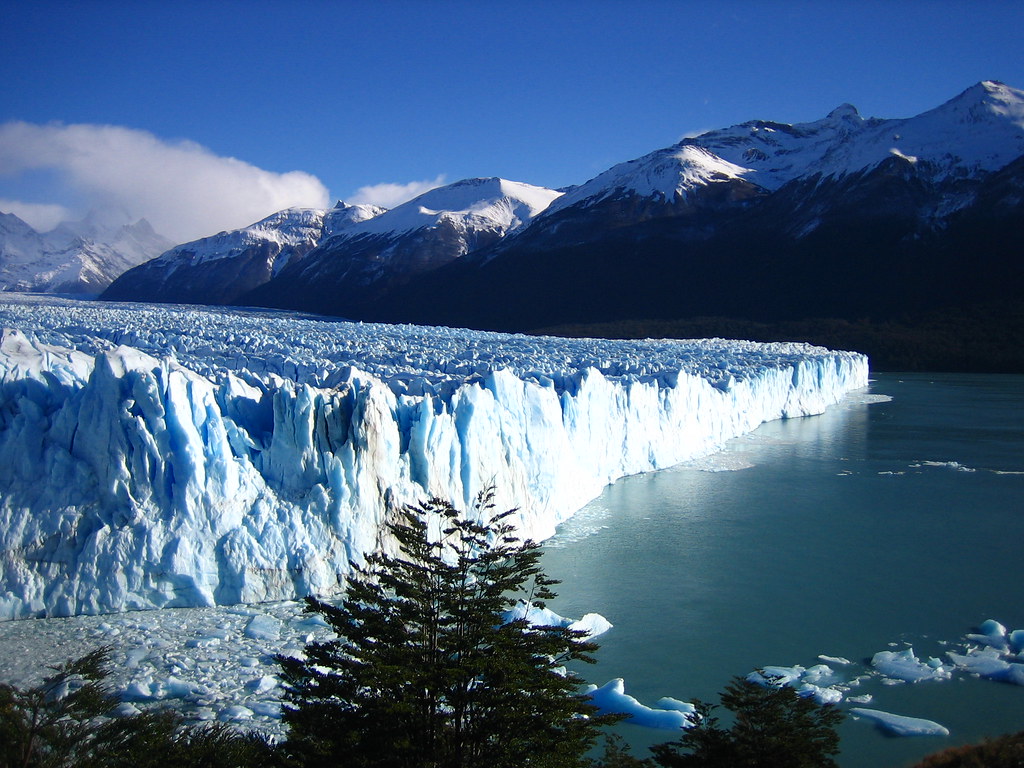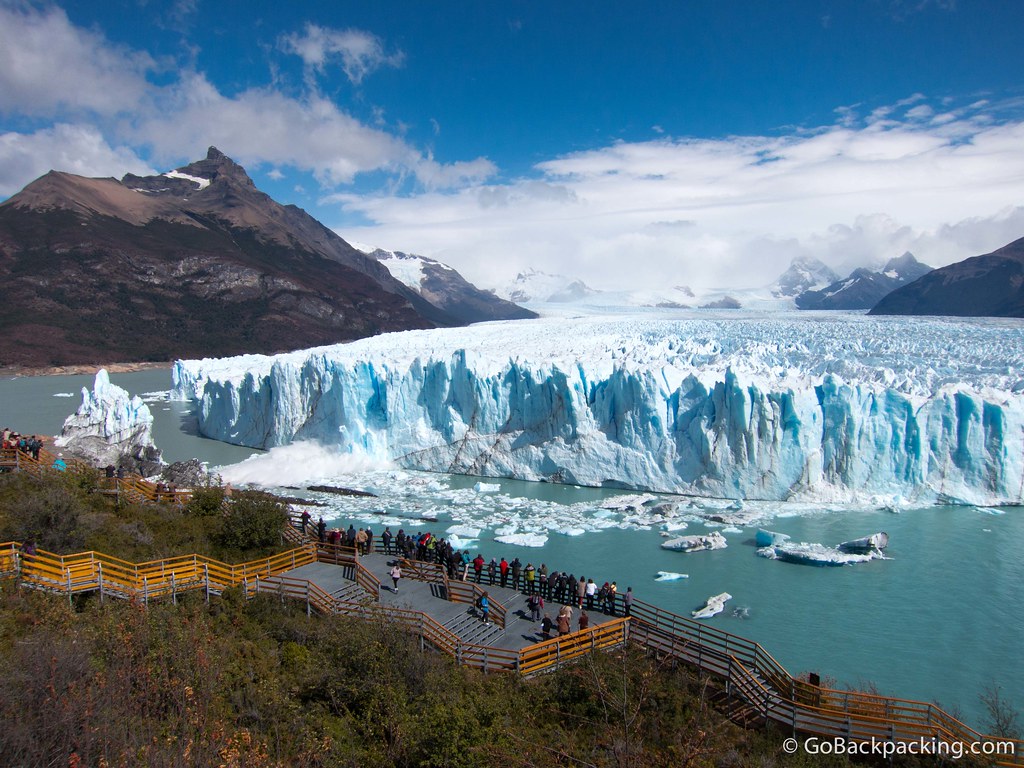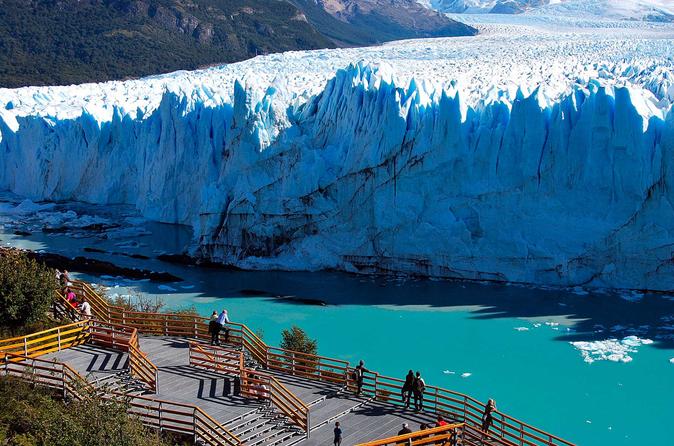Perito Moreno Glacier
End of the glacier Perito Moreno glacier in 2004, two weeks before the Brazo Rico ( below), the blocked southern part of Lake Argentino, a breakthrough came.
The Perito Moreno Glacier is one of the largest outlet glaciers of Hielo Sur de Campo, the largest glacier area of the South American Andes. It is located in Patagonia in the south-west of Argentina in the province of Santa Cruz. The glacier is known primarily from the fact that its ending in Lago Argentino glacier tongue closes off the southern arm of the lake and dams, which then emptied periodically. It was named after the glacier Perito Moreno, an Argentine geographers, in particular the Patagonia devoted himself. Today, the glacier is one of the biggest tourist attractions in Argentina, he is the most visited place of the classified UNESCO World Heritage National Park Los Glaciares. Unlike most glaciers in the region, the Perito Moreno Glacier is not retracted the mass balance shows no clear trend.
Morphology
The upper limit of the glacier is drawn to the Continental Divide, the ice divide has an average altitude of 2200 m, the highest point is 2950 m at Cerro Pietrobelli. From there, the glacier extends over some 30 km eastward to Lake Argentino. Based on satellite images of 1999, a glacier area of 254 square kilometers was determined.
The glacier reaches the Lago Argentino at its southern reaches and separates two of the side arms of each other, namely the Brazo Rico in the south of the more northerly Canal de los Témpanos. At times, bridged the glacier the entire arm of the lake and reached the opposite shore, in the far west of the Magellan Peninsula. The calving front in the Canal de los Témpanos is 2.3 km long, 2.1 km and the length of the front on the west side Magellan Peninsula is located in the Brazo Rico at 0.5 km. The height of the calving front is 55-77 meters above the waterline. The deepest part near the front in the Brazo Rico is 110 m, in the Canal de los Témpanos are there 164 m. The glacier is a floating tongue at any point. The Kalbungsgeschwindigkeit is in the middle of the front in the Canal de los Témpanos greatest, there is a value of 795 meters per year was determined.
Periodic impoundment and the outbreak of the Brazo Rico
From the first usable photo of the glacier from 1899 can be seen that the former glacier terminus was one kilometers above the present glacier front. In the following years before he came to there was the first documented damming the Brazo Rico 1917. In the meantime, there were more than 20 such impoundments and discharges, typically the process is repeated every two to four years. During the damming in 1965 is reported from a water level rise of 28.4 m in the Brazo Rico, but this seems exaggerated because the vegetation in the area of the southern side arm suggests a maximum increase of 23.5 meters, and the water would at drain an increase of more than 25 meters above the deeper areas in the northeastern area of the Brazo Rico and thus prevent a further increase.
In the years 1988-2003 the glacier reached several times the opposite shore, but it was not too spectacular eruptions, as the water could run through channels in the ice. In 2003 the glacier front Témpanos came in Canal de los around 100 to 120 meters in front, in the Brazo Rico, it was 150 meters. In September 2003, the glacier eventually blocked the outflow of the Brazo Rico from complete. The area of the southern part of Lake Argentino - Brazo Rico and Brazo Sur - increased in the subsequent period of approximately 150 km ² to 172 km ², the water level rose 9.35 meters. On March 11, the water started to break through, first through cracks in the ice, which widened. Two days later broke a 60 -meter-high part of the ice front together. Just two years later, on 13 March 2006, it came to the next such collapse of the ice dam. The following outbreak on 9 July 2008, the Argentine Independence Day, was the first known collapse during the winter months. This unusual time could be related to the global warming related. The former last outbreak occurred in March 2012.
Development of the glacier
Unlike most glaciers in the region, the Perito Moreno glacier is not retracted. The mass balance of the last decades shows no clear trend. The reason for this behavior may lie in the geometry of the glacier.
Here, on the one hand plays the glacier terminus in Lago Argentino a role. There the glacier abuts the opposite shore of the lake at the Magellan Peninsula, also the water depth increases before the two glacier fronts on the right and left of it rapidly, which is also there to prevent a further advance of the glacier since the Kalbungsgeschwindigkeit increased significantly with increasing water depth. The Kalbungsgeschwindigkeit is unusually large for ending in freshwater glaciers, which suggests that this is one reason why the calving front of the glacier is so stable in recent decades.
Another reason for the stability of the Perito Moreno glacier could be that the glacier is relatively steep in the region of the equilibrium line; the increase in these 100 meters just means some reduction of Nährgebiets by 4 percent.
History
The glacier was formerly Bismarck Glacier. In 1899 it had its discoverer, the German geologist Rudolph Hauthal, named after the late last year former Chancellor Otto von Bismarck. He was named later to Perito Moreno, as an acknowledgment of its merit as an explorer and anthropologist. In Germany the name Bismarck Glacier was common until at least 1917.
Environment
Nearest town is around 80 km away, El Calafate, a popular starting point for tours of the National Park and the glacier.










